Microorganisms play an important role in the sewage treatment plant biochemical system debugging, later stable operation and process adjustment. They are good sewage treatment indicators.
By microscopically examining the microbiological status of activated sludge, relevant trait information of the activated sludge can be obtained, which will play a certain role in guiding the production.
IRO has organized and sorted out the characteristics of 24 kinds of microorganisms, living environment and the impact on sewage treatment. This is part 1 (12 kinds of microorganisms).
| Name | Classification | Noumenon | Form | Zoology | Picture |
|---|---|---|---|---|---|
| Aspidisca | activated sludge protozoa | length: 25-40μm, width: 19-29μm | Small size, A is a three-sided circle, the front is the most narrow, the back is the widest and flat, a little obtuse, the back is protruding, the front of the four hairlines, tilted into a row, three abdominal hair, column In the first half, there are 5 hip hairs, which are quite long and thin, and are arranged obliquely in the rear. | Bacteria as food have a wide ecological range, but they are extremely sensitive to chemical substances and can be used as biological indicators for the determination of toxic substances. Actinopteryceps can be used as an indicator organism for good water quality treatment. When there is a lot of water, the treated water has a BOD of 15 mg/l. However, when there are too many worms, the number of 2000 worms per ml or more will be constantly turned over in the activated sludge, which will also affect the sedimentation effect of sludge. | 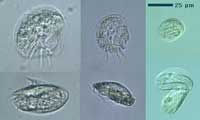 |
| Colepidae | activated sludge protozoa | length: 55-65μm, width: 28-32μm | The body is in the form of a barrel-shaped grenade, with a slight swelling in the middle, and the ratio of body length to body width is about 2 to 1. The shape is fixed and is more or less than; the plate shells formed by the exoplasm are 15 – 20 lines and the plate shells are divided into six segments by the transverse grooves, each forming a certain form and number of “panes.” The cilia are evenly distributed throughout the body, and the ostium is located at the forefront. It is not easy to see through the cilia. | The shell insects can catch algae, small flagellates, and small ciliates, as well as sucking up dead rotifers. It often occurs when the BOD load is low, the dissolved oxygen concentration is high, and the treated water BOD is low. | 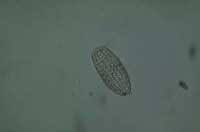 |
| Stylonychia | activated sludge protozoa | length: 110-120μm, width: 45-50μm | The shape is oblong, but the two sides are almost parallel. There are depressions at the edge of the mouth. The cilia system has 8 frontal tentacles, 5 abdominal tentacles, 5 hip touches, and two prominent clitoral protrusions. In vitro, the body is very stiff, and the tails of the three tails are long and hard and have short bristles. The action is not lively, sometimes it stays for a while, and the body is full of algae sucked into it. | Feeding mainly on algae and flagellates as food sources, and sometimes also on rotifers, is not common in activated sludge, and the treated water BOD is usually low when present. | 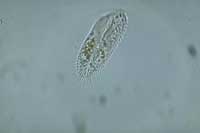 |
| Euplotes eurystomus | activated sludge protozoa | length: 135-230μm, width: 75-98μm | The body is firm and does not bend or change shape. It is broadly oval. The back is more or less convex, the ventral surface is flat, the back half is slightly narrower than the front half, the back is rounded, and the mouth area is quite large and long. There are 7 tentacles, 5 hips, and 4 tail hairs. The telescoping bubble is located on the right side of the posterior half. The large nucleus shows a long band. | It mainly uses flagellates and ciliates as foodstuffs, and sometimes swallows unicellular algae. Frequently, when the BOD load is low, the treated BOD is usually about 10 mg/l, which is an active sludge protozoa. | 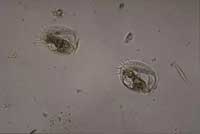 |
| Vorticella micostoma | activated sludge protozoa | length: 32-70μm, width: 22-48μm | The body is approximately circular, but its length is usually still significantly greater than the width, the front port is small and narrow, the enlarged middle is the widest, and the cilia is slightly smaller than the mouth around the front and back. The endoplasm is milky white or light brown, often contains a considerable number of vesicles, the stalk is relatively slender, and the filaments are sheathed in the shank. When stimulated, they expand and contract. Living alone, there are few clumping habits, and the swimming body is slender, cylindrical and moves quickly. | Bacteria as the main food, but also prey on micro-unicellular algae, the most suitable temperature is 25 °C, if it is above 35 °C will form a package or deformity, and finally died, a large number of cases in the case of better treatment of water quality Most of the BOD is below 20mg/l. | 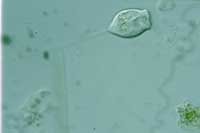 |
| Vorticella Convallaria | activated sludge protozoa | length: 55-105μm, width: 35-58μm | The relatively long bell-shaped worm also has an approximately cylindrical shape, and a few are relatively rough. The peripheral edge of the front port is wider than the main body, and the rear end is gradually tapered toward the handle. The size of the mouth-circulating disc with cilia is compatible with the inner periphery of the mouth. The endoplasm contains a lot of oval bubbles, often with some yellow colour. The shank is of moderate thickness, but it is quite long. There are myofilament sheaths in the shank, which will expand and contract when stimulated. Seldom live alone, love to grow together. The swimming body is thick and cylindrical and moves quickly. | Bacteria are used as foodstuffs, and sometimes unicellular algae are also eaten. When the treated water quality is good, the treated water has a BOD of 15 mg/l or less. |  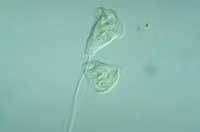 |
| Carchesium | activated sludge protozoa | length: 80-125μm, width: 38-60μm | The form of the dromedary is basically the same as that of the bell, except that it has formed a colony. Since the sheaths of the branched filaments are not continuous but interrupted, each branch can only be stretched individually. The main body has a long bell shape with the widest section at the front, and the general length and width ratio is 2:1; the first shank of the worm body turns more or less downwards and hangs downward. | With bacteria as the main foodstuff, it is common during the biological treatment of wastewater and has a clarification and promotion effect on sewage. The dominance of the Drosophila was good when it was propagated, and the water was transparent and clear. | 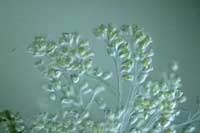 |
| Epistylis | activated sludge protozoa | length: 95-160μm, width: 30-40μm | Individuals are slender or nearly cylindrical, and their shanks do not contract at all because of the absence of myelin sheaths. The body width is about 1/2-1/3 of the body length, the frontal port is larger, and has a cilia mouth. The circumference of the enclosure is smaller than the circumference of the mouth and can be prominently projected beyond the edge of the circumference of the mouth. The endoplasmic reticulum is milky white, contains a small number of vesicles, has a large and retractable blister, and is located at the front end. The handle has a moderate thickness and is relatively smooth. | Using bacteria as a food source, preference is given to feeding E. coli, Pseudomonas, etc.; in a biological treatment system, more is present in the biofilm than in the activated sludge. In general, the treated water BOD is quite low when the larvae appear. | 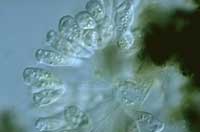 |
| Opercularia Coaractata | Opercularia Coaractata | length: 45-56μm, width: 19-23μm | Comparing with larvae, the main difference lies in the straight edge of the mouth, and it will never form “marginal lips”. Usually, the edge of the mouth circumference is also jagged and the body resembles a pear or oval shape. The central area is significantly enlarged and widest. The front and rear ends are more or less thin, and the front port is wider than the middle. The pellicle surrounding the exoskeleton is smooth, invisible to the presence of membranous lines, endoplasmin milky white, with a small number of vesicles, a very thin, delicate handle, a smooth surface, irregular branching and fork-shaped; The group is not big. | Taking food-intaking bacteria as a food source, in particular, like Streptococcus, Pseudomonas, Bacillus subtilis, etc., often at a load of 0.2-0.4 kg BOD/kg MLSS/day, and the treated water quality is good. | 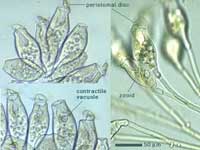 |
| Pleuromonas | inactive sludge protozoa | length: 6-10μm, width: 3-5μm | The body is small, generally kidney-shaped, with rounded ends, with 2 flagella. The shorter swing of one flagellum is more sensitive to the lack of dissolved oxygen, and it makes a quick rotation when observed under a microscope. | Trichomonas bacteria as the main food, in terms of the ecological environment, is suitable for the pollution and more polluted water bodies. A large number of free bacteria in the water is the basic condition for its large-scale reproduction, so its large number of occurrence is often a high sludge load, sludge disintegration, bacterial micellar decomposition, reduced transparency of treated water quality, COD, BOD indicators increased. | 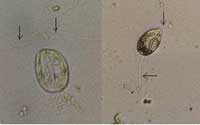 |
| Bodo | inactive sludge protozoa | length: 11-15μm, width: 5-7μm | The body is small, oval in shape, with a slightly curved, pointed corner at the front and a rounded back end. Two flagella originated in the front end and protruded from inside the cell mouth. Flagella is an active organ and a food collecting organ, so it is very active. | Bacteria are used as foodstuffs, and in terms of ecological habits, they are a-stained and more polluted. It is a representative of non-active sludge protozoa. It often appears when the BOD load is high and the dissolved oxygen is low. If it is dominant, the treated water is turbid, and most of the BOD is above 30 mg/l. | 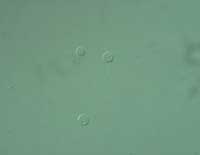 |
| Colpoda | inactive sludge protozoa | length: 11-15μm, width: 5-7μm | The body is kidney-shaped, the right edge is semicircular and evenly curved, the back end is relatively round, the back end is relatively thin when starving, the mouth is located in the middle of the left edge of the middle of the body, and the mouth vestibule becomes a shallow armpit; Body cilia evenly distributed. There are scattered food bubbles in the body. | The source of food is mainly bacteria, reniform prefers Aerobacter aerogenesand Serratia marcescens occurs most often under high load conditions with a BOD load of around 0.7 KG. Less occurs under normal system operating conditions. | 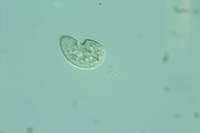 |
Title:
Microflora Analysis of 24 Microorganisms and Their Guiding Significance in Water Treatment (part 1)
Source: https://www.irohedp.com/microflora-analysis-water-treatment/